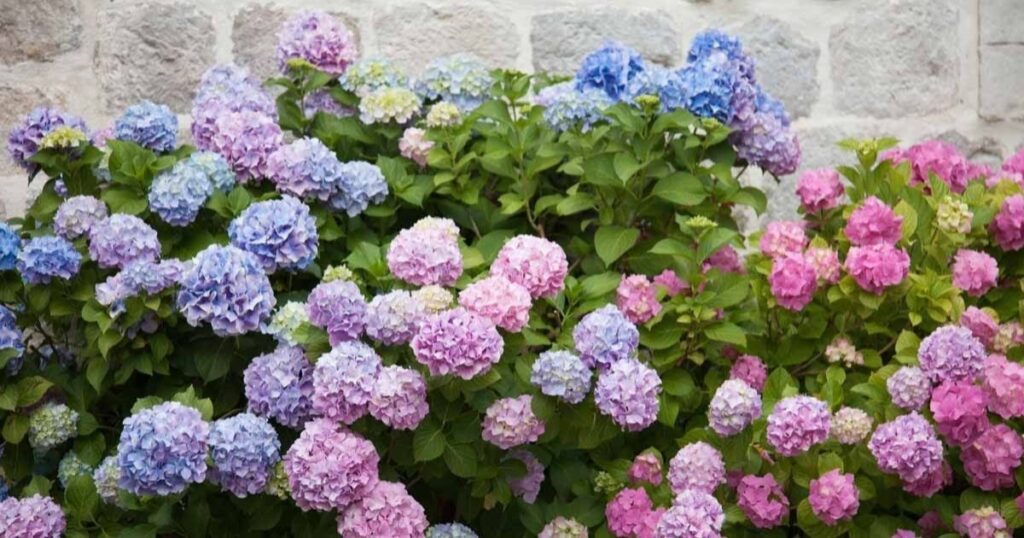Spring Splendor: Unveiling the Ultimate Hydrangea Fertilization Guide for Breathtaking Blooms
Hydrangeas are the crowning glory of any spring garden, their vibrant blooms adding a burst of color and elegance to the landscape. However, achieving those coveted, show-stopping displays demands more than just a green thumb it requires a strategic approach to fertilization. In this comprehensive guide, we’ll unveil the secrets to nourishing your hydrangeas for breathtaking blooms, ensuring your garden is the envy of the neighborhood.
The Best Way To Fertilize Hydrangeas
Fertilizing hydrangeas is a delicate art, and timing is everything. To unlock their full potential, these flowering shrubs require precise nutrient application at crucial growth stages. By understanding the optimal fertilization schedule and techniques, you can maximize your hydrangeas’ bloom potential and elevate your garden to new heights.
2 Crucial Times To Fertilize Hydrangeas
Hydrangea care revolves around two critical fertilization periods: late winter/early spring and just before blooming. These windows of opportunity are essential for promoting vigorous growth and stunning floral displays.
#1 Late Winter / Early Spring Fertilizing
As winter’s chill begins to fade, your hydrangeas awaken from their dormancy, signaling the start of the growing season. This is the perfect time for early spring fertilization, providing a gentle boost to stimulate foliage development and prepare the plants for the upcoming bloom cycle.
The key to successful early spring fertilization lies in using a balanced, slow-release fertilizer or a generous layer of nutrient-rich compost. These organic sources release a steady stream of essential nutrients, promoting steady growth without overwhelming the plants. Avoid high-nitrogen fertilizers, as they can encourage excessive foliage at the expense of blooms.
#2 Fertilizing Before Blooming – The Best Way To Fertilize Hydrangeas
As your hydrangeas begin to form buds and prepare for their floral debut, it’s time for the second crucial fertilization. This bloom enhancement step is vital for maximizing the size, vibrancy, and longevity of your hydrangea blossoms.
Unlike the early spring feeding, this application calls for a fertilizer rich in phosphorus and potassium the key players in flower production. A well-balanced fertilizer with an N-P-K ratio around 10-30-20 is ideal, providing ample phosphorus and potassium to support robust blooming while still supplying a moderate amount of nitrogen for foliage growth.
Selecting Your Fertilizer – The Best Way To Fertilize Hydrangeas
Choosing the right fertilizer is paramount for hydrangea success. Look for specialized bloom boosters or flowering plant fertilizers that are formulated to encourage vibrant blooms. These products often contain higher phosphorus and potassium levels, along with essential micronutrients that support plant health and flowering.
For optimal results, apply the bloom booster fertilizer directly to the soil around the base of your hydrangeas, and water it in thoroughly. This ensures the nutrients are readily available for root absorption, fueling your plants’ blooming efforts.
Nourishing Nature’s Beauty: The Definitive Approach to Fertilizing Hydrangeas for Stunning Spring Flowers

While fertilization is crucial, it’s essential to remember that hydrangea care extends beyond mere nutrient application. Several other factors can influence your plants’ blooming potential, and addressing them in tandem with proper fertilization will yield the most magnificent results.
Other Bloom Factors – The Best Way To Fertilize Hydrangeas
Soil Quality: Hydrangeas thrive in well-draining, slightly acidic soil rich in organic matter. Amending your soil with compost or peat moss can improve drainage and nutrient retention, creating an optimal growing environment for your plants.
Light exposure: Most hydrangea varieties prefer partial shade to full sun, depending on your climate. Ensuring your plants receive the appropriate amount of sunlight can significantly impact their blooming prowess.
Pruning: Proper pruning is essential for encouraging abundant blooms. Bigleaf, Oakleaf, and climbing hydrangeas should be pruned immediately after flowering, as they produce their blooms on old wood. Conversely, Smooth and Panicle hydrangeas can be pruned in late winter or early spring, as they bloom on new growth.
When To Prune – How To Fertilize Hydrangeas For Bigger Blooms
Pruning hydrangeas at the right time is crucial for maintaining their blooming cycle. For varieties that bloom on old wood (Bigleaf, Oakleaf, and climbing hydrangeas), prune immediately after flowering to avoid removing next year’s buds. For those that bloom on new growth (Smooth and Panicle hydrangeas), late winter or early spring pruning is recommended before new growth emerges.
Remember, light pruning is often sufficient for maintaining plant shape and encouraging air circulation. Avoid excessive pruning, as it can hinder blooming and disrupt the plant’s natural growth patterns.
Also read this post:Fertilize Pepper Plants
Hydrangea Happiness: Elevating Your Garden with Expert Fertilization Techniques for Abundant Blooms
By implementing the proper fertilization schedule and techniques outlined in this guide, you’ll be well on your way to creating a hydrangea haven in your garden. From late winter’s gentle awakening to the pre-bloom nutrient boost, each step plays a vital role in supporting your plants’ growth and ensuring a spectacular spring floral display.
Embrace the art of hydrangea care, and let your garden become a canvas for nature’s vibrant masterpieces. With patience, attention to detail, and a strategic approach to fertilization, you’ll unlock the full potential of these stunning flowering shrubs, transforming your outdoor space into a true oasis of springtime splendor.
Bloom Boost: Insider Tips for Fertilizing Hydrangeas to Achieve Show-Stopping Spring Flowers
Achieving a breathtaking hydrangea display is not only about following the right fertilization schedule but also about employing expert techniques and gardening tips. Here are some insider tips to help you maximize your hydrangeas’ bloom potential and create a true showstopper in your spring garden.
- Soil testing: Before applying any fertilizer, it’s crucial to understand the nutrient levels and pH of your soil. A simple soil test can provide valuable insights and help you tailor your fertilization approach accordingly. Hydrangeas thrive in slightly acidic soil, so adjustments may be necessary to achieve the desired pH range.
- Consistent moisture: Hydrangeas are water-loving plants, and maintaining consistent soil moisture is essential for optimal bloom production. Mulching around the base of the plants can help retain moisture and regulate soil temperatures, creating an ideal environment for root growth and nutrient uptake.
- Micronutrient boost: While macronutrients like nitrogen, phosphorus, and potassium are crucial, don’t overlook the importance of micronutrients. Incorporate a balanced micronutrient fertilizer or foliar spray to ensure your hydrangeas receive a comprehensive nutrient profile, supporting overall plant health and bloom development.
- Timing is key: Adhere to the recommended fertilization schedule, but also pay attention to your local climate and growing conditions. Adjust the timing as needed to align with your hydrangeas’ specific growth patterns and blooming cycles.
- Deadheading: Regularly removing spent blooms (deadheading) can encourage your hydrangeas to produce more flowers. This practice redirects the plant’s energy towards new bloom formation, resulting in a longer and more abundant blooming season.
By incorporating these insider tips into your hydrangea care routine, you’ll be well on your way to achieving show-stopping spring flowers that are the envy of your neighborhood. Remember, patience and attention to detail are key when it comes to nurturing these stunning flowering shrubs to their full potential.
Hydrangea Elegance: Crafting Gorgeous Spring Blooms Through Optimal Fertilization Practices

Hydrangeas are the epitome of spring elegance, their lush blooms adding a touch of sophistication to any garden setting. To achieve this level of floral grandeur, it’s essential to prioritize optimal fertilization practices tailored to these exceptional plants.
By following the guidelines outlined in this comprehensive guide, you’ll be well-equipped to provide your hydrangeas with the precise nutrient requirements they need to flourish. From the gentle awakening of late winter to the pre-bloom nutrient boost, each step plays a crucial role in supporting your plants’ growth and ensuring a spectacular springtime display.
Embrace the art of hydrangea care, and let your garden become a canvas for nature’s vibrant masterpieces. With patience.
Blossom Bonanza: Unlocking the Secrets to Hydrangea Fertilization for Magnificent Spring Blossoms
Spring is the season of renewal, and what better way to celebrate this time of rebirth than by cultivating a bountiful blossom bonanza in your garden? Hydrangeas, with their stunning blooms and lush foliage, are the perfect candidates to usher in the warmer months with a burst of color and elegance. However, achieving a truly magnificent display requires unlocking the secrets of proper hydrangea fertilization.
Fertilizing hydrangeas is not a one-size-fits-all endeavor; it’s a delicate dance of timing, nutrient ratios, and soil preparation. By mastering these essential elements, you’ll be well on your way to creating a springtime spectacle that will leave your neighbors green with envy.
Spring Fertilization: A Symphony of Nutrients
Just as an orchestra requires a harmonious blend of instruments, hydrangeas thrive when provided with a carefully orchestrated blend of nutrients. The key to unlocking their full blooming potential lies in understanding the specific nutrient requirements at different growth stages.
Early Spring Nourishment: As winter’s chill gives way to the warmth of spring, your hydrangeas will awaken from their dormancy, signaling the start of a new growth cycle. This is the perfect time to provide a gentle, slow-release fertilizer or a nutrient-rich compost. These organic sources will supply a steady stream of essential nutrients, encouraging vigorous foliage development and setting the stage for a spectacular blooming season.
Pre-Bloom Boost: As buds begin to form and your hydrangeas prepare for their floral debut, it’s time to shift gears and focus on bloom enhancement. A specialized fertilizer rich in phosphorus and potassium, with an N-P-K ratio around 10-30-20, will work wonders in promoting larger, more vibrant blossoms. These key nutrients play a crucial role in flower production, helping your hydrangeas reach their full blooming potential.
Soil Nourishment: The Foundation for Floral Splendor
While fertilization is undoubtedly essential, it’s important to remember that hydrangeas are only as spectacular as the soil they’re planted in. A well-nourished and balanced soil provides the ideal foundation for your plants to thrive, ensuring that the nutrients you provide are readily available and efficiently utilized.
Amending your soil with nutrient-rich compost or well-aged manure can work wonders in improving soil structure, drainage, and nutrient retention. Additionally, maintaining a slightly acidic soil pH (between 5.5 and 6.5) is crucial for hydrangeas, as it influences their ability to absorb essential nutrients and even impacts the color of their blooms.
Gardening Tips for Big Blooms

While fertilization and soil preparation are the cornerstones of a successful hydrangea garden, there are several other gardening tips and techniques that can further enhance your blooming success:
- Consistent Moisture: Hydrangeas are water-loving plants, and maintaining consistent soil moisture is key to preventing wilting, promoting healthy growth, and supporting abundant bloom production.
- Proper Pruning: Pruning your hydrangeas at the right time is crucial for ensuring a consistent blooming cycle. For varieties that bloom on old wood, prune immediately after flowering to avoid removing next year’s buds. For those that bloom on new growth, late winter or early spring pruning is recommended before new growth emerges.
- Sunlight Exposure: Most hydrangea varieties thrive in partial shade to full sun, depending on your climate. Ensuring your plants receive the appropriate amount of sunlight can significantly impact their blooming prowess and overall health.
- Deadheading: Regularly removing spent blooms (deadheading) can encourage your hydrangeas to produce more flowers, redirecting the plant’s energy towards new bloom formation and extending the blooming season.
By combining the art of hydrangea fertilization with these complementary gardening practices, you’ll be well on your way to creating a truly breathtaking springtime display. Embrace the joy of nurturing these magnificent plants, and let your garden become a canvas for nature’s vibrant masterpieces.
Fertilize for Flair: Maximizing Hydrangea Bloom Potential with Spring Fertilization Tactics
As the warmer days of spring approach, gardeners eagerly anticipate the arrival of one of nature’s most vibrant displays the hydrangea bloom. These stunning flowering shrubs are the epitome of springtime elegance, with their lush foliage and vibrant blooms adding a touch of sophistication to any garden setting. However, achieving the full potential of these floral marvels requires a strategic approach to fertilization.
Maximizing your hydrangeas’ bloom potential is a delicate balance of timing, nutrient ratios, and soil preparation. By mastering these essential elements, you’ll unlock the secrets to cultivating a truly breathtaking display that will leave your neighbors in awe.
Timing is Everything: The Rhythm of Spring Fertilization
Proper fertilization timing is crucial for hydrangea success, as it aligns with the plant’s natural growth cycles and ensures that the right nutrients are available at the appropriate stages. The rhythm of spring fertilization for hydrangeas follows a two-step cadence:
- Late Winter/Early Spring Awakening: As the last remnants of winter fade away, your hydrangeas will begin to stir from their dormancy, signaling the start of a new growth cycle. This is the ideal time to provide a gentle, slow-release fertilizer or a nutrient-rich compost. These organic sources will supply a steady stream of essential nutrients, encouraging vigorous foliage development and setting the stage for a spectacular blooming season.
- Pre-Bloom Boost: As buds begin to form and your hydrangeas prepare for their floral debut, it’s time to shift gears and focus on bloom enhancement. A specialized fertilizer rich in phosphorus and potassium, with an N-P-K ratio around 10-30-20, will work wonders in promoting larger, more vibrant blossoms. These key nutrients play a crucial role in flower production, helping your hydrangeas reach their full blooming potential.
FAQ,s
What is the best fertilizer for hydrangeas in spring?
For late winter/early spring fertilization, use a balanced, slow-release fertilizer or nutrient-rich compost to provide steady nutrients as the plants come out of dormancy. Avoid high-nitrogen fertilizers that promote excessive foliage growth at the expense of blooms.
What to put on hydrangeas to make them bloom?
Right before your hydrangeas bloom, apply a fertilizer high in phosphorus and potassium, around a 10-30-20 N-P-K ratio, to boost flower production. This specialized bloom-boosting feed gives plants the nutrients they need for bigger, more vibrant blooms.
What fertilizer changes the color of hydrangeas?
The soil pH level determines hydrangea flower color, not the fertilizer itself. To change the bloom color, amend the soil with aluminum sulfate or lime to adjust pH – a lower pH produces blue blooms, higher pH creates pink.
What do you add to the soil for hydrangeas?
Amend hydrangea soil with compost or well-rotted manure to improve structure, drainage, and nutrient levels. Also maintain a slightly acidic 5.5-6.5 pH by adding amendments like peat moss, pine bark, or fertilizers formulated for acid-loving plants.











